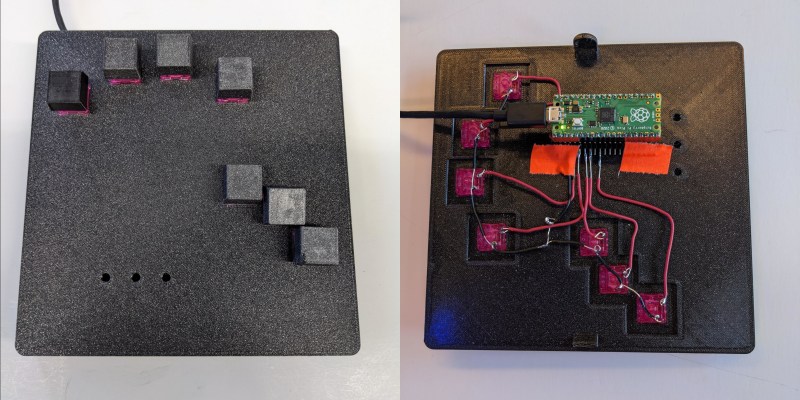[akmnos22] was getting tired of moving one hand to the mouse and back to the keyboard. Rather than integrating mouse controls into a keyboard, they decided to really lean in and create a chording keyboard — one that creates characters with combinations of key presses, like playing chords on a piano.
This project was inspired in part by the Infogrip BAT, which has graced these pages before. Much like the BAT, this uses a total of seven Cherry MX switches: one for each finger, and three for the thumb. In order to get the placement just right for you, [akmnos22] suggests laying your hand in a comfortable position on a piece of paper and marking where your fingers naturally rest, then importing these markings into CAD software to decide where the key switch holes should be.
The brains of this operation is a Raspberry Pi Pico, which provides more than enough GPIO pins to do the job. [akmnos22] does a nice job of explaining exactly how to put one of these together, from the design concept through the programming process and how to actually chord on the thing.
Would you rather chord with two hands? It might be even faster.
















I wonder how much it could be improved by adding a key that you could palm with the base of your pinky, like the way a lot of people use the control key to keep from having to stray too far from the home row.
“I heard there was a secret chord[ed keyboard]“
It should also be possible to make a keyboard with adjustable key positions. you could even hide the difference by having the keycap be the farthest point on a sliding element that can disappear under the palm rest.
I have to make a chording keyboard one of these days, but the ultimate goal is a keeb for a wearable PC
Or make the key positions slots the switch can slide up and down inside. Put a dab of epoxy or print some covers to hold it once you’ve got the location down. Or use bolts, possibly socket head cap screws to pinch it from top and bottom if you are feeling steampunk.
the classic ibm keyboard with the red clit is an answer
For those using this kind of keyboard, is it practical, compared to a standard keyboard?
I can type around 100 wpm on a regular keyboard, but have only hit 10 wpm on this chording keyboard. Part of the slowdown is just not being used to it and not having all the chords memorized – I’ve been busy with other things and haven’t found much time to practice the chords. So far, I’ve only spent 1-2 hours max on the keyboard across various typing sessions, so there’s definitely room for improvement.
All I want is a half-keyboard with an extra button to flip the layout so I can type the other half using the same hand. I know it should be possible with some of the open firmwares, but I just haven’t invested the time into learning how to build one and figure it out.
I’ve seen on this site and elsewhere something about mirroring software for standard keyboards for unidexterious use, maybe even in windows accessibility settings.
I suspect the patent by the Half Keyboard company has expired by now, or will pretty soon.
I forget if it had a special shift key or used the spacebar.
It was the one one-handed design that made sense to me for regular use, because it’s easy to remember (especially since they marked the keycaps for it.)
The other fairly easy one-hander I’ve seen was to get a 40% size keyboard and learn to touch-type 1-handed, with your home position over the middle.
A while back when I had an RSI scare I wrote some X software that would turn a gaming keypad into a chording keyboard. It worked really well. Only problem is that actually teaching myself to type on it turned out to be way harder than writing the software. http://cowlark.com/narcissus/
What comparisons are there between RPI Pico and AVR 32u4 ProMicro for USB HID projects ? Speed? Cost? Availability?
Once a user get used to chording with this, does the author think 100WPM can be achieved or exceeded?